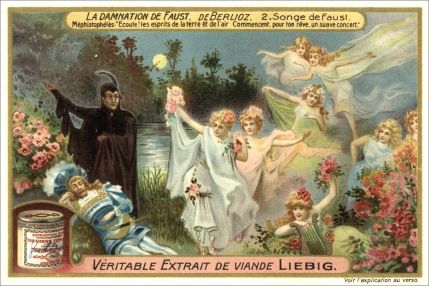Exhibition
Musically Themed Liebig Cards – Part I
March 2021
In 1847, Justus von Liebig, later Baron Liebig, the eminent German chemist at the Royal Pharmacy in Munich, published a treatise Extractum Carnis. He believed that the beef extract he could produce would prove to be a nourishing food for the populace in general and the poor in particular. To raise money for the venture, he set up the Liebig Extract of Meat Company (LEMCO) in London in December 1865. It proved to be very successful and thirty years later the extract that his company produced was being distributed widely around the world. The product, which was originally sold in stone jars of various sizes, evolved over the years and went through several changes of brand name. It finally became the solid Oxo cubes that we know today. Liebig Extract was heavily advertised in many forms and their decorative cards were an instant success.
An Alphabet of Male Operatic Roles
1. Title role in Asrael by Alberto Franchetti & title role in Belisar by Gaetano Donizetti. 2. Title role in Columbus (Cristoforo Colombo) by Alberto Franchetti & Daland in Der fliegende Holländer by Richard Wagner. 3. Title role in Ernani by Giuseppe Verdi & title role in Fra Diavolo by Daniel Auber.
1. Title role in Guarany by Antônio Carlos Gomes & Hermann in Loreley by Alfredo Catalani. 2. Icilius in Virginia by Saverio Mercadante & Jago in Othello by Giuseppe Verdi. 3. Klingsor in Parsifal & title role in Lohengrin both by Richard Wagner.
1. Title role in Mephistopheles by Arrigo Boito & Nelusco in Die Afrikanerin by Giacomo Meyerbeer. 2. Title role in Othello by Giuseppe Verdi & Peter der Grosse in Der Nordstern by Giacomo Meyerbeer. 3. Quesada in Don Juan von Oesterreich by Filippo Marchetti & Rhadames in Aida by Giuseppe Verdi.
1. Siegmund in Die Walküre by Richard Wagner & title role in Torquato Tasso by Gaetano Donizetti. 2. Urias in Mirella by Charles Gounod & Vasco di Gama in Die Afrikanerin by Giacomo Meyerbeer. 3. Wolfram von Eschenbach in Tannhäuser by Richard Wagner & title role in Zampa by Ferdinand Hérold.
N.B. Cards for the letters X and Y were omitted from the original series.
These Liebig cards were especially colourful, many being printed by a twelve-colour process of chromolithography. More than 1,800 sets were issued between 1872 and 1973. They covered a huge variety of subjects including history, peoples of the world, literature, art, sport, the military and nature. At least 76 sets are based on musical subjects. Most sets consist of six cards and a few of twelve. Each card measured approximately 7 x 11 cms and was printed in either landscape or portrait format. These attractive cards, which soon became very collectable, were published in a number of languages, mostly German, Italian and French but also a few in English, Bohemian, Danish, Dutch, Flemish, Hungarian, Russian, Spanish and Swedish. All the cards had a picture on the front incorporating the Liebig stone jar in the design and on the back usually either text about the product or recipes, overprinted with the signature in blue of the founder Justus von Liebig. For collectors, the backs of the cards also have great importance. From the early 1900s, cards depicting six scenes from an individual opera additionally had a short summary of the scene on the reverse of each card.
Tannhäuser. Opera in three acts by Richard Wagner (1813-1883). First performed 19 October 1845 at the Hoftheater, Dresden.
La Damnation de Faust. ‘Légende dramatique’ in four parts by Hector Berlioz (1803-1869) subsequently adapted as an opera in five acts and first performed as such at L’Opéra de Monte-Carlo, 18 February 1893.
L’Africaine. Opera in five acts by Giacomo Meyerbeer (1791-1864). First performed 28 April 1865 at the Salle Le Peletier, Paris.
The first opera cards were issued in 1886 reflecting the operatic repertoire in France, Germany and Italy. Few of these works are regularly performed today.
Six French Composers
Scenes from Operas
1. Die Weisse Dame by François Boieldieu (1775-1834). 2. Fra Diavolo by Daniel Auber (1782-1871). 3. Der Barbier von Sevilla by Giacomo Rossini (1792-1868).
1. Mignon by Ambroise Thomas (1811-1896). 2. Paul und Virginie by Victor Massé (1822-1884). 3. Carmen by Georges Bizet (1838-1875).
Finding early on that the extract was expensive to produce in Europe, Liebig went into partnership in 1865 with George Christian Giebert, a railway engineer working in South America. Cattle were being bred there specifically for their hides, the carcasses being discarded. Giebert realised that the meat from these cattle could be utilised to produce large amounts of Liebig’s extract more cheaply than in Europe and established a factory at Fray Bentos in Uruguay. About 100 kilometres upstream on the opposite bank there was a second factory at Colon, Argentina, also on the Uruguay River which formed the border. The low-cost product was then transported in bulk to Liebig’s company in Europe based in Antwerp.
The Liebig Factory in Antwerp
1. Rinsing the empty jars. 2. Liquifying the extract. 3. Potting, weighing and capping the extract.
1. Sealing the jars with a special machine. 2. Putting a wax seal on the crates of jars. 3. Crates ready to leave the factory.
These are the backs of a set entitled Nos Aïeules (‘Our Grandmothers’) with a card for each decade between 1800 and 1860 illustrating a hat and/or a hairstyle with a separate vignette of a contemporary social scene.
Jennie Bisset
© Museum of Music History 2021.



















































